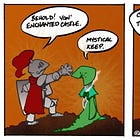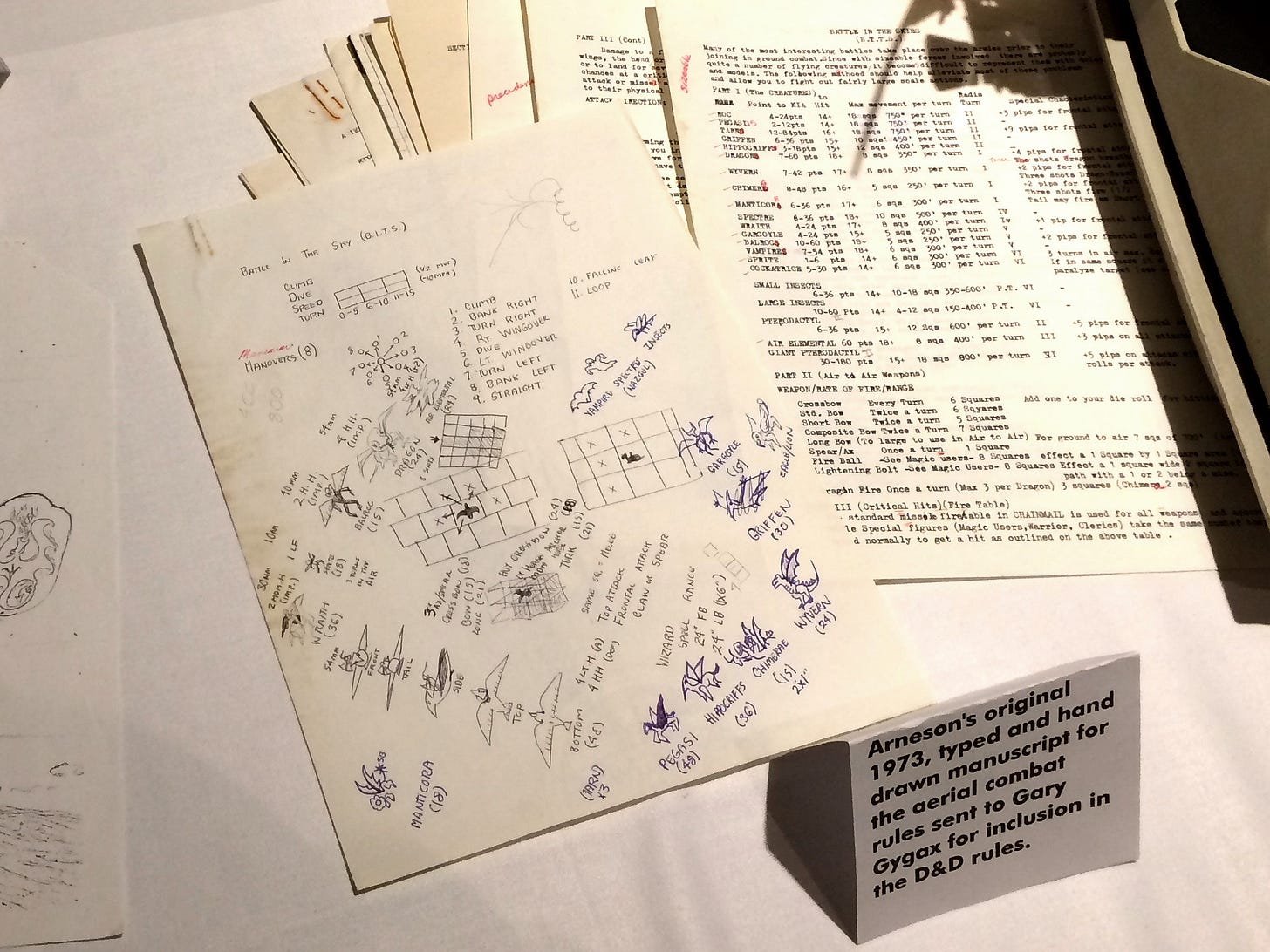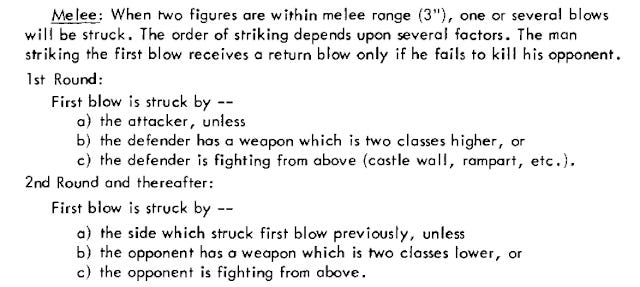Initiative in OD&D: Remember when D&D Combat was "Simpler" and "Easier" to Understand than 5e? Me Either. (Part 2)
D&D Loves its subsystems
Proposing a Series of Articles
Last year, I posted the first in a series of articles discussing the complexity of early editions of the Dungeons & Dragons role playing game.
With each new edition of the D&D game, some players like to reminisce about how much easier to understand to play the game was "back in the day." The fact is that the old game was extremely complex and difficult to understand for neophytes. Heck, as an experienced gamer I had trouble understanding how to play OD&D (that's the little brown books) and I could only figure out how to play Chainmail because of my experience playing Warhammer Fantasy Battle.
While it would be fun to do a read through of all the little brown books, that isn't the intention of this series. This is just to show how complex OD&D combat was, and later how complex Basic and AD&D were as well, starting with the little brown books and moving forward into the various supplements and official articles that expanded the combat rules.
The first few articles will cover the following topics:
Initiative -- The Turn Order. Who goes first and when and how do they go?
Hitting and Damaging Characters and Monsters and Why Do We Have So Many Subsystems?
Wait! What?! That’s Why Tunnels & Trolls is Designed that Way! (An interlude into interpreting Chainmail based D&D combat).
Expanding Play with Greyhawk (followed by the other supplements).
Background — How Many Combat Systems Does Original D&D Have?
Combat in Original D&D has two main subsystems, Chainmail and the "Alternative Combat System." There are numerous references to Chainmail in the rules, which indicates that using Chainmail was a possible way to play D&D even though David Arneson made it clear that those rules were expanded upon and changed over time. In fact, it is likely that no one ever actually played using the Chainmail rules for combat. Reading Rob Kuntz’s description of the first time he and Gary played the game that would eventually be come D&D at Dave Arneson’s house suggests to me that many of the modern assertions that Chainmail was never used are overstatements, but as much as I think the game was Chainmail related it certainly wasn’t Chainmail.
The fact of the matter is that the Chainmail rules, as will be evident after this series of articles, are a robust miniatures game but they provide a difficult to adapt combination of subsystems when trying to make a role playing game. Regardless of those difficulties, the Original D&D rulebooks contain a number of references to the Chainmail combat system and how to use them as the basis for a D&D combat system.
Here are some examples:
On page 5 of Men & Magic (Book 1 of OD&D), the rules list Chainmail under "recommended equipment."
Elves (page 8 of Men & Magic) "also gain the advantages noted in the Chainmail rules..."
Halflings (page 8) "they will have deadly accuracy with missiles as detailed in Chainmail."
Fighting Capability (page 18) "to use in conjunction with the Chainmail fantasy rule, as modified in various places herein..."
On page 5 of Monsters & Treasure "Special ability functions are generally as indicated in Chainmail."
Page 5 of Monsters & Treasure "Combat is Detailed in Vol. III"
Page 25 of Vol. III (The Underworld & Wilderness Adventures) "Land Combat: The basic system is that from Chainmail, with one figure representing one man or creature..."
These are just some of the examples from the book, and they leave out the brief and not very revealing mentions of the Alternative Combat System, so it's pretty clear that whether or not the creators of the game had moved on from Chainmail and were playing using the Alternative Combat System that the rules assume play with Chainmail is possible.
Let me repeat this. Playing D&D using Chainmail as your combat system is possible. Using it creates challenges and potential inconsistencies, but it is possible (also it makes Fighting Men awesome).
No place is the possibility to use Chainmail as the combat system more clear than in the lack of rules for initiative in the Original D&D rule books. The first mention of initiative processes is under "Aerial Combat" in Book III where they recommend simultaneous movement. These aerial rules were adapted from typed and hand drawn rules Dave Arneson sent to Gary Gygax for use in the D&D game. These rules should not be confused with the mysterious “18 pages of rules” that David sent Gary that supposedly outline Arneson’s mechanical foundation for the game.
While the Original D&D rulebooks recommend using simultaneous movement for Aerial Combat, reminiscent of Dawn Patrol, There is no such recommendation for Land Combat, so we are left without a written initiative system in the OD&D books and must look to Chainmail or another source for our solution.
Thankfully such a solution is available in the Chainmail rules set.
Chainmail Initiative
What does initiative in Chainmail look like?
Just like Original D&D has two combat systems, the Chainmail System and the Alternate Combat System, Chainmail has two initiative systems. Over the years, as we go through the many editions of D&D, we will see that D&D is fond of having multiple subsystems for a single action.
Chainmail’s two initiative systems are a Move/Countermove system and a Simultaneous system. Since Book III only specifically recommends the simultaneous system for "Aerial Combat" and "Naval Combat," but not for "Land Combat," I'm going to assume that the standard method for initiative in D&D Land Based Combat follows the Move/Countermove system in Chainmail. Using the Move/Countermove system allows for more variation of play and creates more mechanical, rather than oppositional, narrative friction. While simultaneous systems allow for Clausewitzian friction due to lack of information, die based initiative systems base their uncertainty on an abstract mechanical process rather than secrecy. This dampens the adversarial nature of combat and since a Dungeon Master is a referee and not opponent it seems more in the spirit of the game to use a mechanical system.
Here is a brief breakdown of that system.
Ignoring split-moves for the moment because those are for missile fire by specific troop types and don’t come into play as often, leaves us with the following steps: movement, pass-through fire, artillery fire, missile fire, and melee. This system actually follows a simple format that can become intuitive with repetition.
Each player rolls 1d6. The player with the higher roll moves first and the lower roll moves second. There are no modifiers for high Dexterity or anything like that in the original rules.
After all movement the players resolve any melee combats.
In the initial discussion of the turn sequence, there is no way to determine who goes first in melee combat. In fact, basic melee resolution in Chainmail is simultaneous in nature, "After both players have rolled the number of dice allotted to them for their meleeing troops by the Combat Tables, casualties are removed, and morale for both opponents is checked (Chainmail, 15)."
In the basic initiative system, all combat is simultaneous. This has certain advantages and disadvantages. While simultaneous combat reflects well mass battles, it lacks the granular narrative satisfaction of a one at a time initiative system. The main Chainmail system, however, is designed for mass combat where figures represent actual people at a ratio of 1:20, so it makes sense to use this for that kind of action. The challenge comes later in the Chainmail rulebook when we are given a more detailed account of determining who goes first in man-to-man fights.
Wait? Is that another subsystem? Damn. D&D loves subsystems. Can’t wait to get to Eldritch Magic’s initiative system in a future entry.
From this we know that characters enter Melee combat when they are within 3" on the table (30 feet in OD&D per Book III page 8). Take a moment to thing about that. You are in melee range when you are within 30 feet of your opponent. This suggests a hard zone of control system.
In addition to clarifying the zone of melee combat, the rules also let us know that the initiative system in combat is no longer simultaneous, if you kill your opponent there is no return blow. This makes going first important. So, who goes first?
"The attacker" is the first option. One imagines that the attacker is the player who moved the figure into within 3" and initiated combat.
UNLESS the defender has a weapon that is two classes higher, or the defender is fighting from above..."You cannot win Anakin! I have the High Ground!"
Figuring out who has the high ground is easy, but what are these weapon "classes"? Those are listed on a chart on page 41, but I've made a new version for reference below.
Weapon classes are listed next to the weapon with higher numbers referring to longer weapons. This is where the weapon class mention above comes into play and if a defender has a weapon two classes higher than the attacker then the defender attacks first. For example, if a warrior with a sword charges a man with a pike it is the pikeman who strikes first (12 is significantly higher than 4).
It is important to note that who acts first might change in the second and later rounds of combat. As stated above, the first attack in the second round is:
Struck by the person who attacked first last round, UNLESS...
The opponent has a weapon two classes lower, or
The opponent is fighting from above.
If we assume the same "sword vs. pike" scenario above, the character who strikes the first blow in the second round will shift from the pikeman to the swordsman. This would reflect the swordsman getting past the pike and closing the distance during the prior minute of combat. Combat in OD&D is minute long combat rounds. As stated in Book III (page 8) "Movement is in segments of approximately ten minutes...Melee is fast and furious. There are ten rounds of combat per turn." The minute long combat round helps to explain why Dexterity doesn't play a role in the initiative system. This provides a realistic, if complex, initiative system for how combatants engage with one another in melee.
Now that we have a basic understanding of the melee order, we can ask what "split-moves and missile fire" and "pass-through fire" are, since these can happen before melee. "Split-move and missile fire" is a relatively unique ability possessed by special light horse troops in Chainmail. On page 12 of the Chainmail rulebook, it describes "Split-move and Fire" as follows, "Horsemen armed with bows are permitted to perform this type of movement. To accomplish a split move and fire, the horse archers move up to one-half of their normal movement, immediately conduct missile fire procedure and continue to move out the balance of their normal movement, not to exceed one-half of their normal movement. The horse archers may be fired upon by opponent missile troops during their firing pause."
While one might be tempted to limit "Split-move and Fire" actions to specially trained troops in D&D, that doesn't seem to be the intention here. While it is true that this kind of action is inspired by Mongol horsemen, it is the fact that the move action is done by the horse rather than archer that allows for the ability to fire during movement. This seems to imply that any mounted combatant in OD&D should be allowed this ability if they have proficiency in bows. Chainmail's Man to Man Fantasy Supplement section states that Elves may split-move and fire on foot.
You'll note that the quote above mentions that "horse archers may be fired upon" during their movement, even though this happens outside the "missile" phase of combat. That is because of the possibility of "Pass-through Fire" which allows "stationary missile troops...to give pass-through fire to any enemy units which are within their missile range at the half-move portion of the turn. This would include any enemy troops split-moving, passing by, or charging missile troops." This means that the "missile fire" component of the combat round actually happens during two possible segments of the combat round. It can either happen during the movement phase "at the half-move portion of the turn" or during the missile combat phase.
While this process seems simple at first it is confounded by the rate of fire rules for missile weapons, which state, "Crossbowmen, Archers, and Longbowmen may fire every turn. If Archers and Longbowmen do not move and are not meleed at the end of the turn, they may fire twice." The ability for stationary units to fire twice adds some complexity to the rules as this can mean that a missile unit fires once during "Pass-Through and Fire" and once during the "Missile Fire" phases of combat, or just twice in the "Missile Fire" phase.
This all makes for an extremely complex initiative system that has dynamic realism, but is anything other than simple. Let's illustrate this with a simple combat between four combatants: (A) A Human Swordsman, (A) A Human Archer, (B) A Goblin Spearman, and (B) A Goblin Archer. These combatants meet in a clearing.

For the sake of argument, we'll say that group A wins the initial roll and gets to move first and that the squares represent 10 feet instead which was standard for earlier editions of D&D. To make things simple, we will assume that all figures can move 12" during combat. This example will only cover initiative and not resolution.
Having the first movement, the swordsman rushes to close the distance and charges ahead toward the Goblin Spearman. As he is in range of the Goblin Archer, he triggers pass-through fire as he makes his way towards the Goblin Spearman. Assuming the Goblin Archer failed to kill the Human Swordsman, that character can enter melee combat as soon as it is within 3" of the Goblin Spearman.

Since the Human Swordsman can move 12", and since we ruled it survived "Pass-Through" fire, the figure can continue until it is in base to base contact with the Goblin Spearman and engage in a "Charge" move. This would allow, and would in fact require, the Human Swordsman to continue moving if he defeated the Goblin Spearman in combat.
Now that Player A has moved all the combatants desired, in this case only the Human Swordsman, Player B has the opportunity to move. Seeing there is an Archer, the player elects not to move and suffer "Pass-Through" fire.
All movement being completed, it's time for the Melee round to begin. It's important to note that the Goblin Archer is not necessarily engaged in combat as page 15 of Chainmail states "Missile Troops interspaced with other footmen forming a defensive line may "refuse" combat and move back 3" out of combat range. However, if the other footmen who are meleed are killed or driven away, the missile troops must fight if the attacker is able to continue his charge move." In this case the Human Swordsman charged and would benefit from this if it killed the Goblin Spearman. Since this is 1:1 combat, we will move the Archer back 1" rather than move it off the map.

Now that the two Melee units are in contact and the Movement phase is complete, we must resolve missile combat. The Human Archer (A) has not moved and may thus fire twice at opponents. The Human Archer can choose to fire both shots at the Goblin Archer, split them between the Goblins, or fire both at the Goblin Spearman. They are able to do this because as an "Archer or Longbowman (they) may fire over the heads of intervening troops, friendly or enemy, providing they are more than 3" distant. Indirect fire reduces the range of the weapon firing by one-third. Indirect fire automatically classifies the target in the next higher armor category..." The Goblin Archer, having moved 3" to avoid melee, can only fire once. These shots will be resolved simultaneously as they fire at one another.
Having finished the missile phase, we resolve the melee. In our example we have a Swordsman attacking a Spearman. If both had been wielding swords (weapon class 4), the Human Swordsman would have gone first, but the Goblin is a Spearman (weapon class 8) which is more than 2 classes higher than the Human's and thus the Goblin attacks first. If the Human lives, then it may strike again. These two figures are locked in melee combat until one is killed or routed by the other. There is a strict Zone of Control here.
If all combatants survive, a new roll is made and combat starts at the beginning with movement, then missile fire, then melee. During this second round of Melee, the Human Swordsman will attack first because it has a weapon 2 classes or more LOWER than the opponent and has managed to get through the weapon's reach.
As you can see, this is a very complex system. It is likely more complex than it was actually played, but having worked my way through it I see it as a very workable system that would have benefited from clearer writing. It's also a system I just might try to use in a few session in the future.
The next post will discuss how to hit and damage opponents using the Chainmail based system for combat and not the Alternative System.











Whenever I think of the early game's initiative systems, I also start comparing to the initiative system in Magic Realm (AH, 1979) which took a lot of these systems and formalized them... into a system that was just as confusing.
Hey just saw you had taken off your original article (it seems, can't find it anymore). It was a big inspiration and I did my own article in French article on the same subject https://dmtrex.wordpress.com/2024/08/23/linitiative-originale/, citing yours! I will check that serie and just subscribed to your newsletter. Keep up the good work :) !